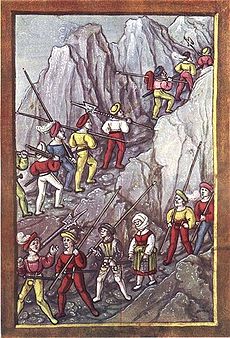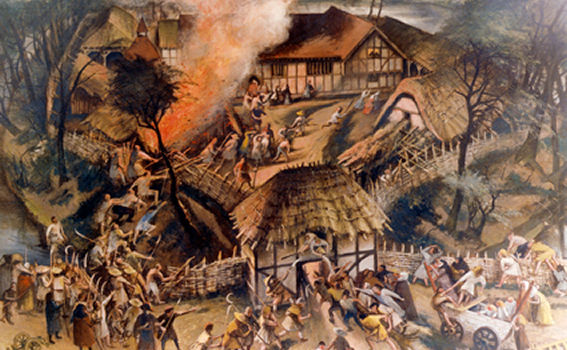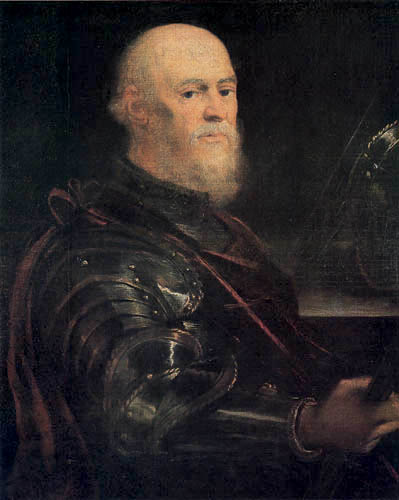Thank you for the support! Here is the next update
“Amor de fradeło, amor da korteło”
“Love between brothers is love made with knives”
-Łuixzi Eriso commenting the actions of the Pope

Doge Agneło Parteciako
The election of Agneło Parteciako (or Participazio) as Doge represented the true revolution of the period. Since the formal acquisition of political independence from both the Frankish and the Byzantine empires, Venice had grown in fame and power; but it was far from being important on the world stage. It was likely for Charlemagne, king of the Franks and Emperor of the Romans, to attack the city, but there were two main reasons why he wouldn't: first, the treaties had just been stipulated, and second, Venice was still in the interests of the Byzantine emperor, who would had intervened in a potential war. Taking advantage of the situation, Doge Parteciako managed to improve the international relations with the two great powers. He sent a ship full of several spices which his country imported from foreign countries, and though it was nothing compared to the richness of Byzantium, the emperor Nikephoros I accepted the gift. More important was the treat signed with the Franks on January 811, a few days after the Doge's election: to assure its freedom it was agreed that the Frankish army should be allowed to step into the venetian territory. After these events, the Bulgarians started to assault the Empire from the east, making it impossible (in a few years) for it to engage other wars.
The two wars with the Papal State
In 811 Pope Leo III, who crowned Charlemagne Imperator Augustus on Christmas Day, 800, guaranteed the autonomy of the newborn Republic. As the following events revealed, it was only a way to guarantee the city for himself. On August and Semptember 813, Leo III repeatedly insulted the Doge's authority in his Sunday celebrations and public speeches, often stating the “inacceptable existence of Venice in front of God” with the pretext of the recent secession from the allied Franks. Eventually, in January 814 Leo III declared war upon Venice, and San Marino and the Asturias honoured their alliance with the church.
The first Papal-Venetian war was nothing but a border friction. The city was defended by three thousand soldiers and almost two thousand people volunteers, but nothing could have been done against the ten thousand strong papal-sanmarinian army; despite everything, the enemy never crossed the borders because of the importance that the Fankish Empire and its relations with the involved countries still had in the national stabilities. Between February and March 816 San Marino and the Asturias accepted a white peace and at the beginning of the new year the Pope too signed the peace for war inactivity.

The Papal Army was composed most of mercenaries
Eight years were passed, and three Doges had been elected (Łuixzi Mèstre (815), Fabrisio Dołfìn (819) and Łuixzi Eriso (823)), when the Pope declared war once again in 824. This time it was for real: almost fifteen thousand soldiers walked through the italian peninsula, from Rome and San Marino to Venice, passed the border and faced the small venetian army. The battle lasted only one day, and the combined militia of the church besieged Venice. The capital lost many of its men, and the walls almost fell, but Doge Eriso finally managed to sign a peace with the Pope: during December 826 Venice conceded defeat, and the hostile army eventually got off the city, leaving it in misery.

The siege of Venice in a later picture. Accented are the fear of the people and the fire, set from the Sanmarinian archers.
The montenegrin expansion and the sicilian revolts
Since the disastrous outcomes of the second Papal War, it was clear for the Venetians and the tribunes that the province needed stronger defenses and a tougher army. It was therefore elected a military candidate as the leader of the Republic, and his name was Carło Dołlfìn, brother of Fabrisio. He ruled from 827 to 831, and the most notable things he did were the erection of tougher walls to protect the city and the first attempt to build a strong navy. In 831 Marjo Trevixzàn, also a military, was the first truly important Doge for Venice. He built numerous alliances: the duchy of Barcelona, the duchy of Sardinia and later the duchy of Gotland, or Christian duchy of the Swedes; he then proceded to build a strong and numerous army (some seven thousand men) and to ensure them a better training than before.
In March 832, he thought the newly reformed army was ready for the first war of aggression of the Republican history: he sent the seven thousand men via mare, across the Adriatic, to the lands of Montenegro, declaring war against the small country, recently seceded from Byzantium. The army proved its strenght in the battle of Ulcinj, where it fought three thousand Serbian soldiers. The battle lasted two days, after that the venetians could put under siege all the principality. The voivod of Montenegro surrendered on June 1st 834, while his land was almost entirely occupied by the venetian forces. The peace included enormous losses for the voivodship: it had to annul all the international treaties, to pay 25 Ducats and to cede the provinces of Niksic, Pljevlja and Ulcinj, as well as the city of Trieste on the istrian coast.
In addition to these provinces, Venice had gained two more cities in the past years. Sicily was a possession of the Byzantine empire, but its inhabitants were of lombard culture, similar to the venetian culture. During 831 what has been called the Sicilian Revolts resulted in the annexation of Catania and Messina (Catanja and Mesina in the Venetian language): their citizens revolted against Byzantium, that was too busy resisting to the Bulgarian invasions to take care of its peripheral regions, and finally declared fidelity to the Republic of Venice, after Doge Trevixzàn suggested it to the rebels' chiefs.
Marjo Trevixzàn was re-elected in 835 and 839 due to his good work in the first four years of government, but had to leave the place to the Burocrat Pjero Połjàn in 843.

Venice in 834
The fall of the Frankish Empire
The 9th century had not been a good one for the Franks. They ceaselessly faced the Bulgarian invasions, and until 826 they seemed to resist without great problems. But the continuous attacks of Khans Krum and his son Omurtag finished to wear them out. It looked like an endless war, with no peace signed ever, and the death of Charlemagne in 826 was a crucial event for the Empire. From that moment on, it only lost men and territories to the nomads, but it hold its apparent integrity under the regency for William the Carolingian and his own reign. William died in June 837 and his son Octavius Henry was still too young to hold the country; his regency council wasn't able to handle the situation and eventually took a dramatic decision in 842: to split the empire into four different and independent kingdoms and to put them under the control of previous important dukes and counts. Those were: the kingdom of France (King Henry I de Montfort), the kingdom of Rohania (King John William I de Rohan), the empire of East Francia or Carolingia, virtual heir of the ancient Frankish power, and the voivodship of Dalmatia (Voivod Almos I Kotromanic).

The split of the Frankish Empire: Blue is France, Red is Rohania, Gold is Carolingia and purple is Dalmatia
This ended the Carolingian Europe, but not the Carolingian Period: the last member of the dynasty died on November 5th 920 in a dishonorable way.
Act I – Of compromises and astuteness
Part 1: The Carolingian Europe
Part 1: The Carolingian Europe
“Amor de fradeło, amor da korteło”
“Love between brothers is love made with knives”
-Łuixzi Eriso commenting the actions of the Pope

Doge Agneło Parteciako
The election of Agneło Parteciako (or Participazio) as Doge represented the true revolution of the period. Since the formal acquisition of political independence from both the Frankish and the Byzantine empires, Venice had grown in fame and power; but it was far from being important on the world stage. It was likely for Charlemagne, king of the Franks and Emperor of the Romans, to attack the city, but there were two main reasons why he wouldn't: first, the treaties had just been stipulated, and second, Venice was still in the interests of the Byzantine emperor, who would had intervened in a potential war. Taking advantage of the situation, Doge Parteciako managed to improve the international relations with the two great powers. He sent a ship full of several spices which his country imported from foreign countries, and though it was nothing compared to the richness of Byzantium, the emperor Nikephoros I accepted the gift. More important was the treat signed with the Franks on January 811, a few days after the Doge's election: to assure its freedom it was agreed that the Frankish army should be allowed to step into the venetian territory. After these events, the Bulgarians started to assault the Empire from the east, making it impossible (in a few years) for it to engage other wars.
The two wars with the Papal State
In 811 Pope Leo III, who crowned Charlemagne Imperator Augustus on Christmas Day, 800, guaranteed the autonomy of the newborn Republic. As the following events revealed, it was only a way to guarantee the city for himself. On August and Semptember 813, Leo III repeatedly insulted the Doge's authority in his Sunday celebrations and public speeches, often stating the “inacceptable existence of Venice in front of God” with the pretext of the recent secession from the allied Franks. Eventually, in January 814 Leo III declared war upon Venice, and San Marino and the Asturias honoured their alliance with the church.
The first Papal-Venetian war was nothing but a border friction. The city was defended by three thousand soldiers and almost two thousand people volunteers, but nothing could have been done against the ten thousand strong papal-sanmarinian army; despite everything, the enemy never crossed the borders because of the importance that the Fankish Empire and its relations with the involved countries still had in the national stabilities. Between February and March 816 San Marino and the Asturias accepted a white peace and at the beginning of the new year the Pope too signed the peace for war inactivity.

The Papal Army was composed most of mercenaries
Eight years were passed, and three Doges had been elected (Łuixzi Mèstre (815), Fabrisio Dołfìn (819) and Łuixzi Eriso (823)), when the Pope declared war once again in 824. This time it was for real: almost fifteen thousand soldiers walked through the italian peninsula, from Rome and San Marino to Venice, passed the border and faced the small venetian army. The battle lasted only one day, and the combined militia of the church besieged Venice. The capital lost many of its men, and the walls almost fell, but Doge Eriso finally managed to sign a peace with the Pope: during December 826 Venice conceded defeat, and the hostile army eventually got off the city, leaving it in misery.

The siege of Venice in a later picture. Accented are the fear of the people and the fire, set from the Sanmarinian archers.
The montenegrin expansion and the sicilian revolts
Since the disastrous outcomes of the second Papal War, it was clear for the Venetians and the tribunes that the province needed stronger defenses and a tougher army. It was therefore elected a military candidate as the leader of the Republic, and his name was Carło Dołlfìn, brother of Fabrisio. He ruled from 827 to 831, and the most notable things he did were the erection of tougher walls to protect the city and the first attempt to build a strong navy. In 831 Marjo Trevixzàn, also a military, was the first truly important Doge for Venice. He built numerous alliances: the duchy of Barcelona, the duchy of Sardinia and later the duchy of Gotland, or Christian duchy of the Swedes; he then proceded to build a strong and numerous army (some seven thousand men) and to ensure them a better training than before.
In March 832, he thought the newly reformed army was ready for the first war of aggression of the Republican history: he sent the seven thousand men via mare, across the Adriatic, to the lands of Montenegro, declaring war against the small country, recently seceded from Byzantium. The army proved its strenght in the battle of Ulcinj, where it fought three thousand Serbian soldiers. The battle lasted two days, after that the venetians could put under siege all the principality. The voivod of Montenegro surrendered on June 1st 834, while his land was almost entirely occupied by the venetian forces. The peace included enormous losses for the voivodship: it had to annul all the international treaties, to pay 25 Ducats and to cede the provinces of Niksic, Pljevlja and Ulcinj, as well as the city of Trieste on the istrian coast.
In addition to these provinces, Venice had gained two more cities in the past years. Sicily was a possession of the Byzantine empire, but its inhabitants were of lombard culture, similar to the venetian culture. During 831 what has been called the Sicilian Revolts resulted in the annexation of Catania and Messina (Catanja and Mesina in the Venetian language): their citizens revolted against Byzantium, that was too busy resisting to the Bulgarian invasions to take care of its peripheral regions, and finally declared fidelity to the Republic of Venice, after Doge Trevixzàn suggested it to the rebels' chiefs.
Marjo Trevixzàn was re-elected in 835 and 839 due to his good work in the first four years of government, but had to leave the place to the Burocrat Pjero Połjàn in 843.

Venice in 834
The fall of the Frankish Empire
The 9th century had not been a good one for the Franks. They ceaselessly faced the Bulgarian invasions, and until 826 they seemed to resist without great problems. But the continuous attacks of Khans Krum and his son Omurtag finished to wear them out. It looked like an endless war, with no peace signed ever, and the death of Charlemagne in 826 was a crucial event for the Empire. From that moment on, it only lost men and territories to the nomads, but it hold its apparent integrity under the regency for William the Carolingian and his own reign. William died in June 837 and his son Octavius Henry was still too young to hold the country; his regency council wasn't able to handle the situation and eventually took a dramatic decision in 842: to split the empire into four different and independent kingdoms and to put them under the control of previous important dukes and counts. Those were: the kingdom of France (King Henry I de Montfort), the kingdom of Rohania (King John William I de Rohan), the empire of East Francia or Carolingia, virtual heir of the ancient Frankish power, and the voivodship of Dalmatia (Voivod Almos I Kotromanic).

The split of the Frankish Empire: Blue is France, Red is Rohania, Gold is Carolingia and purple is Dalmatia
This ended the Carolingian Europe, but not the Carolingian Period: the last member of the dynasty died on November 5th 920 in a dishonorable way.
Last edited:





















